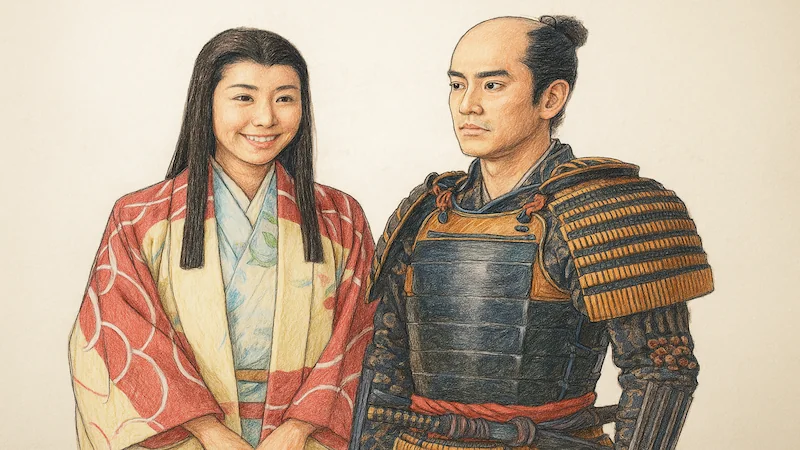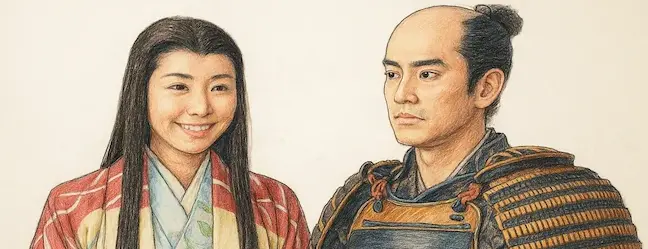
Driven by a Curiosity for History — A New Perspective on the Sengoku Era
As my interest in Japan’s Warring States period grew, I found myself drawn to the great figures of the era — Oda Nobunaga, Toyotomi Hideyoshi, and Tokugawa Ieyasu. Yet one figure consistently caught my attention: Toshiie Maeda. Always in the shadow of the three great unifiers, Toshiie nevertheless possessed an undeniable presence. I felt that by taking a closer look at his life, I could see the Sengoku narrative from a more multidimensional perspective — and that naturally deepened my interest in the Taiga drama Toshiie and Matsu.
Pre-Viewing Knowledge and Expectations
Before watching, my understanding of Toshiie was quite limited. I knew that he had served Nobunaga, maintained a friendship with Hideyoshi, and earned the trust of many after Hideyoshi’s death — but only as fragments. I knew little about his character, family, or how he managed to survive such turbulent times. It was that curiosity about the unknown that became my strongest motivation to watch the series.
Toshiie Maeda — The Historical Figure Behind the Drama
According to historical records, Toshiie Maeda was a master spearman known as “Spear Mataza,” and was deeply trusted by Oda Nobunaga. He distinguished himself in battles such as Okehazama and Anegawa, later serving under Shibata Katsuie in 1574. He played a significant role in suppressing the Ikko Ikki uprisings in Echizen and was awarded 100,000 koku of land in Fuchu, becoming one of the “Three Lords of Fuchu.”
After Nobunaga’s death, Toshiie initially sided with Shibata Katsuie at the Battle of Shizugatake but soon distanced himself, choosing to align with Hideyoshi instead. Strengthening his alliance with Hideyoshi, he governed the Hokuriku region and later, in 1598, became one of the Five Elders — the core council of the Toyotomi government. As a prominent daimyo of the Azuchi-Momoyama period, he played a crucial political role and, after Hideyoshi’s passing, stood as a mediator and counterbalance to Tokugawa Ieyasu.
With this background in mind, the drama’s portrayal of Toshiie as an “honest and compassionate man of integrity” aligns remarkably well with his historical image.
The Drama’s Appeal and Points of Evaluation
Originally aired in 2002, Toshiie and Matsu achieved an impressive average viewership rating of 22.7%, making it one of the most talked-about Taiga dramas of its time. The cast received high praise for their fitting portrayals — Nanako Matsushima as Matsu, Toshiaki Karasawa as Toshiie, Takashi Sorimachi as Nobunaga, and Teruyuki Kagawa as Hideyoshi were all considered “perfectly cast.”
However, not all reviews were glowing. Some critics pointed out inconsistencies in the script and acting, particularly regarding the portrayal of Nobunaga. Others noted discrepancies from historical fact or weak geographical accuracy. Certain viewers also felt that Toshiie’s character was “overly idealized.”
Overall Impression — Honor, Trust, and the Bond of Marriage
What struck me most about Toshiie and Matsu was Toshiie’s unwavering integrity and genuine humanity, alongside Matsu’s quiet yet resilient strength. Their relationship, built on mutual trust and affection, remained steadfast through the chaos of the Sengoku era. In the final scene — where Matsu visits the tree under which she spent her childhood — the theme of “life’s fleeting nature” resonated deeply with me.
The Warmth and Depth of a Marital Story
While the pacing occasionally falters, the drama’s warmth and emotional depth as a story about a husband and wife — and as parents — set it apart from other Taiga dramas. The depiction of Toshiie and Matsu supporting one another, sometimes clashing yet always united, shines all the more brightly against the harsh backdrop of wartime Japan.
Friendship and Complex Human Relationships with Hideyoshi
Equally striking is the portrayal of Toshiie’s deep friendship with Hideyoshi. Both men rose from humble beginnings and took different paths shaped by their personalities and intellect, yet they continued to respect and care for each other. The friendship between Hideyoshi’s wife, One (Nene), and Matsu also adds emotional richness, reflecting the hardships faced by women of their era.
Their relationship goes beyond simple friendship — Toshiie entrusts his daughter Go-hime to Hideyoshi, who had no heir, as an adopted daughter. In his later years, Toshiie was even appointed as the guardian of Hideyori, Hideyoshi’s son, underscoring the profound mutual trust between them. Yet, the emotional turmoil Toshiie faces — torn between his loyalty to his mentor Shibata Katsuie and his friend Hideyoshi during the Battle of Shizugatake — remains one of the series’ most powerful moments.
The Depth of a Grand Historical Ensemble
The drama is further enriched by its ensemble cast of historical figures — the sharp yet calm Ieyasu, the charismatic Nobunaga, and other key players such as Sassa Narimasa and Sawa Kiyosuke, all closely connected to Toshiie. Though some exchanges, like those between Nobunaga and Matsu, are dramatized beyond historical record, they effectively broaden the narrative and enhance its emotional scope. The result is a compelling and weighty portrayal of the Sengoku era as a grand human drama.



comment